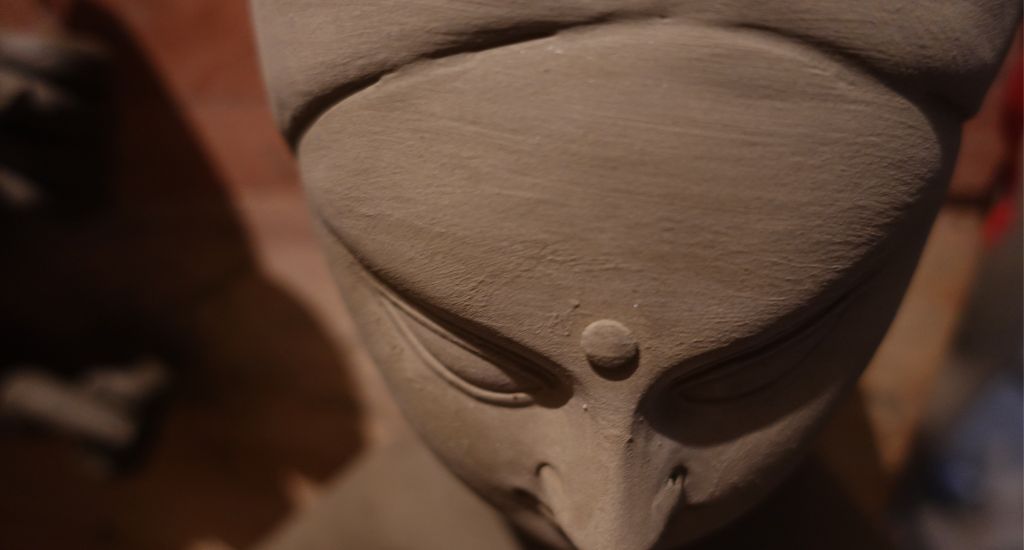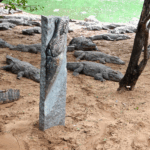Vibrant colours, the scent of fresh paint, diligent artisans adding final touches and eager last-minute idol buyers define Kumhartuli’s bustling streets during Durgo Puja. In this West Bengal village, over 200 skilled artisans specialise in diverse art forms.
Along the lanes, workshops house Durga idols at different stages of completion, with a master crafting the 10-handed goddess, often seen beside a lion.
In 2021, Durga Puja was inscribed on the UNESCO Representative List of the Intangible Cultural Heritage of Humanity.
Durga Puja is a 10-day celebration venerating the Hindu goddess Durga. Communities gather in creatively designed pandals in villages and cities to worship handcrafted clay idols. The festivities, marked by elaborate decorations, culinary delights and folk music and dance, culminate with the immersion of the idols on the 10th day in West Bengal, Bihar and other states in the country.

“Crafting the Durga idols usually begins in February or March, but the ambience and rush in Kumhartuli keeps getting overwhelming as the nine-day festival (called Durgo Pujo in West Bengal, Durga Puja in Bihar and Navratri in other parts of the country) comes closer,” said 35-year-old Aurobind, a fourth-generation sculptor who specialises in making Durga idols.
“I have been making idols for almost 20 years now. It began with my dad perfecting the huge idols and I would help him make the arms, and legs and paint them further. He would let me do it since those were the easier parts,” recalled Aurobind, who has a wife and two daughters. They too actively contribute by engaging in painting and crafting ornaments for the Durga idol.
Also Read: Doll makers of Bengal face bleak prospects
“We have to keep telling our daughter to not spend more than two hours on it so that her studies aren’t disturbed,” Aurobind said.
Six months of preparation
Kumhartuli is an abode for artists with generational roots, alongside those who temporarily relocate for five to six months preceding Durga Puja.

Sundor, a farmer in South 24 Parangas district of West Bengal, migrates to Kumhartuli every March or April.
“I get work of sculpting the idols from workshop owners, primarily from the same individual with whom I’ve been working for about seven years,” Sundor said.
He lives in the workshop owner’s house on a minimal rent which is adjusted in his total payment for idol-making.
The process begins with the construction of wooden frames for casting the idol. Subsequently, it is encased with straw before the application of kneaded, adhesive clay. Afterwards, the idol undergoes a drying phase, followed by the careful smoothing of any cracks with cloth. To achieve the final finish, it is meticulously layered with clay, a step the artisans deem crucial and not easily mastered by all.
Also Read: Bengal’s farmers are behind Kolkata’s stunning Durga Puja pandals

Upon completion, the separately crafted hands, feet and face, shaped by specialised artisans, are affixed to the main body of the idol and then left to undergo the drying process.
One festival, many artisans
Then comes the process of polishing and colouring.
“There are certain artists whose job is just to paint the idol once the sculpting is finished,” said Dilip Thakur, who has been painting idols for 13 years.
“Painting the face of Durga idols is the duty of the master artist since eyes are a very important part of the Bengali Durga idols,” he added. The idols’ eyes are distinct, characterised by their elongated and sharp features. A quick glance at the eyes alone allows one to discern whether the idol is from Kumhartuli or another locale.
One group of artisans focuses solely on crafting the crowns for the idols. Simultaneously, others specialise in fashioning intricate jewellery, while another set designs the idol’s hair.
Also Read: Handcrafted Baluchari sarees see festive resurgence

“We get bookings for many idols. That could be four months in advance and the orders keep coming in till a month ahead of the festival. But even when the festival begins, which is mostly in October or November, buyers come and that’s when we have to lower the prices because if it doesn’t sell at the last minute, it would remain with us and we don’t want to face that loss,” Aurobind said.
“The idol sizes vary from 10 feet to 80 feet tall and so does the price, starting at Rs 20,000 and going up to Rs 2.25 lakh,” he added.
Artisans in Kumhartuli share that while people invest significantly in clothing, jewellery, pandals and food for this festival, they often haggle excessively when it comes to compensating the artisans for the Durga idols they purchase. This practice occasionally results in meagre profits that do not adequately reflect the artisans’ time and labour.
The lead image at the top shows a Durga idol during the making process at Kumhartuli. (Photo by Jigyasa Mishra)
Jigyasa Mishra is a journalist from north India who writes primarily about women’s issues and public health.








